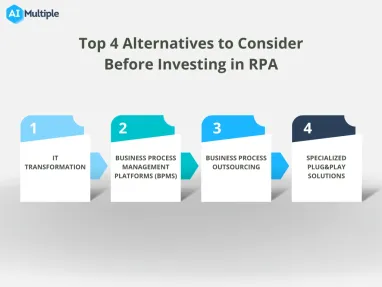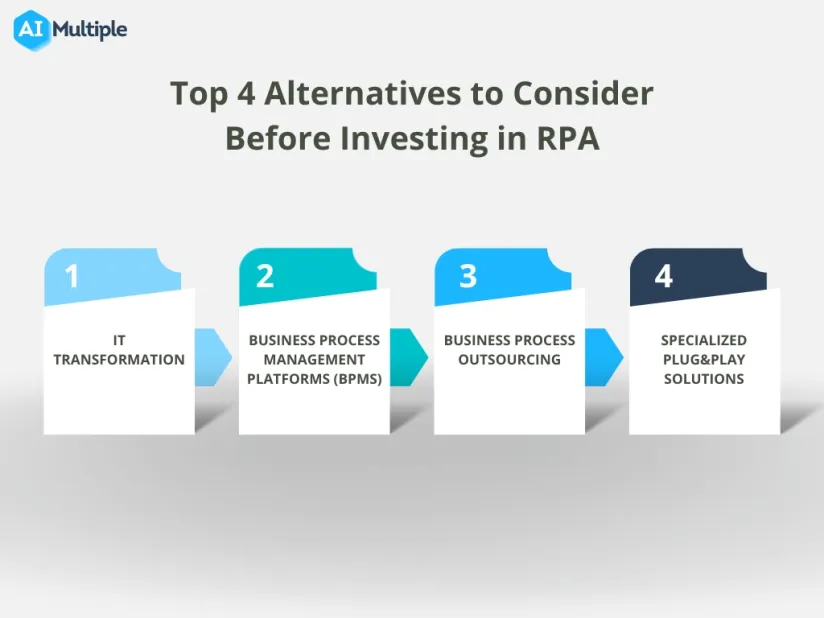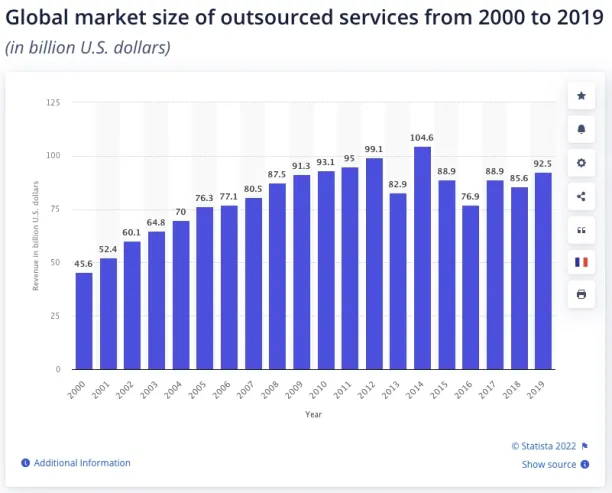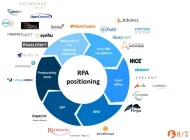Top 4 Alternatives to Consider Before Investing in RPA in 2024


Robotic Process Automation (RPA) is a beneficial technology that can automate up to 70-80% of rules-based processes. However, ~40% of companies fail to reach their expectations of cost reduction after RPA implementation. This is because RPA is not the right fit for every process and there are potential pitfalls of RPA implementation.
To help business leaders choose the right process management approach, we have identified
- 4 major alternatives to RPA
- new developments in RPA that are increasing RPA’s relevance for more processes
Although using RPA’s alternatives require trade-offs, it allows CxOs a wider range of possibilities to find the optimal path for their companies. Here, we lay out such pros and cons so business leaders can be informed before investing in RPA.
1. IT transformation
New system architectures can be built to increase automation on larger scales. However such structural changes will inevitably trigger changes in tools and take significant time and budget to complete.
System upgrades, especially those involving legacy systems, require complex migrations and could take years to materialize. A Mckinsey and Oxford joint study on software projects demonstrated that large IT projects run 45 percent over budget, and 7 percent over time, while delivering 56 percent less value than predicted.
Given such grim statistics, large companies have moved away from delivering comprehensive redesigns of their architectures towards implementing quick fixes that solve their immediate problems.
2. Business Process Management Platforms (BPMS)
BPMS’s integrate enterprise applications to increase the amount of “straight-through processing” possible within a process. BPMS can achieve similar results to IT transformations, but quicker.
However, their benefits can be limited based on the variety of enterprise applications that are used in the process.
To learn more about the benefits of business process management, click here.
3. Business Process Outsourcing
Popular in the 90s, many companies in the developed world outsourced their operations to the developing world. Companies benefited from outsourcing through labor arbitrage and economies of scale of outsourcing providers.
The idea is that, instead of leveraging an RPA bot copy-paste information from one window onto another, you can outsource it so a human labor can do it.
However, with the increased convergence of developed and developing economies and currency fluctuations in developing countries labor arbitrage is losing its former profitability. And with most manual processes already outsourced, corporate leaders have seen that silos, formed as a result of outsourcing, have reduced innovation. This is perhaps why the market size of outsourcing services has been stagnating (see Figure 1).

More fundamental changes are required to improve processes today.
To learn more about the top 5 outsourcing best practices, click here.
4. Specialized Plug&Play Solutions
There are processes that are common across companies that rely on the same systems. New tools that easily integrate into those systems can provide robust and easy-to-integrate solutions.
Accounts payable for example is such a process as all companies need to process invoices, make payments and store the data in ERP systems such as SAP.
Another example is T&E (travel & expense) cost optimization. All companies have these costs and specialized solutions like Appzen are using AI to help companies of different industries to tackle these challenges.
These tools are easy to integrate into existing systems and they allow companies to access leading-edge tools quickly.
However, the downside of such solutions is that they are off-the-rack, and lack the ability to be customized to address a business operation’s specific needs.
Learn RPA’s advantages compared to the alternatives
Compared to these alternatives, RPA provides a very good quick fix thanks to its 4 advantages:
- Flexibility: You can program an RPA bot to complete almost any repetitive task thanks by using customized codes.
- Ease of integration: Thanks to screen scraping, screen recording, and other existing integrations, bots can input and evaluate the output of almost all Windows applications.
- Ease of implementation: Macro recorders and drag&drop programming tools make it easy for citizen developers to program RPA solutions.
- Cost: Robots are cheaper than humans! Business process outsourcing solutions are no longer economical when those processes can be automated with more efficiency and less costs, than outsourcing.
Despite its advantages, RPA is not always the answer
In many cases, RPA can provide robust, automated solutions. However, it is not always the optimal choice. Any of the above 4 choices (IT transformation, BPMS, process outsourcing, and Plug&Play solutions) can be used to manage or eliminate manual processes. If the alternatives have better ROI than an RPA implementation, companies would be wise to follow that route.
To learn more about how you can measure RPA’s ROI, click here.
These are also not mutually exclusive approaches. Companies can invest in transformational system upgrades, while simultaneously leveraging RPA and reaping its benefits, while the platform is being upgraded.
Additionally, innovative RPA solutions, those that leverage IA technologies, such as OCR and NLP, are being developed that tackle the limitations of existing RPA solutions.
While traditional RPA solutions relied on programming and created worflows that needed significant maintenance effort and IT oversight, RPA vendors are working to improve the state of RPA. We covered innovative RPA solutions such as no code RPA and self-learning RPA in our future of RPA article.
There are areas where RPA alternatives can be more preferable than RPA
Visionary CxOs will make the correct investment trade-offs between different solutions. There are 3 obvious areas where alternatives will be preferable to RPA:
- Specialized solutions would be better than generic RPA tools for processes, that are similar across organizations, and which rely on a few software systems. This allows software vendors to learn from numerous companies’ data and build powerful and easy-to-integrate solutions
- IT transformation is required to reduce dependency on risky hardware and software.
- RPA is built to operate on the end terminal or interfacing technology as a component in the overall system architecture. It does not change the underlying system architecture.
- Legacy architectural choices leave companies dependent on costly and hard-to-maintain hardware and software systems. These create vulnerabilities that can result in catastrophic failures. For example, a leading bank in EMEA had a day-long outage of all its systems (even ATMs did not function) because of an update that resulted in a catastrophic failure of a legacy central system.
- For temporary process or rapidly changing processes, BPO could be a cheaper alternative to RPA.
- For rapidly changing processes, maintaining bots can be costlier than maintaining a partially automated BPO operation.
- For temporary processes, the cost of RPA can be higher than running those processes with a human team
To learn more about the processes that are unfavorable for RPA automation, click here.
Optimal choices will enable organizations to function effectively and out-compete their competitors both today and in the future. If you want to employ RPA to achieve this, you can review our data-driven lists of RPA software and consultants.
We can help you make these choices:

Cem has been the principal analyst at AIMultiple since 2017. AIMultiple informs hundreds of thousands of businesses (as per similarWeb) including 60% of Fortune 500 every month.
Cem's work has been cited by leading global publications including Business Insider, Forbes, Washington Post, global firms like Deloitte, HPE, NGOs like World Economic Forum and supranational organizations like European Commission. You can see more reputable companies and media that referenced AIMultiple.
Throughout his career, Cem served as a tech consultant, tech buyer and tech entrepreneur. He advised businesses on their enterprise software, automation, cloud, AI / ML and other technology related decisions at McKinsey & Company and Altman Solon for more than a decade. He also published a McKinsey report on digitalization.
He led technology strategy and procurement of a telco while reporting to the CEO. He has also led commercial growth of deep tech company Hypatos that reached a 7 digit annual recurring revenue and a 9 digit valuation from 0 within 2 years. Cem's work in Hypatos was covered by leading technology publications like TechCrunch and Business Insider.
Cem regularly speaks at international technology conferences. He graduated from Bogazici University as a computer engineer and holds an MBA from Columbia Business School.
To stay up-to-date on B2B tech & accelerate your enterprise:
Follow on

Comments
Your email address will not be published. All fields are required.